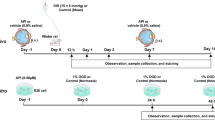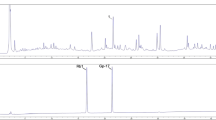Abstract
Purpose
To investigate the neuroprotective effect of idebenone against hydrogen peroxide (H2O2)-induced oxidative damage in retinal ganglion cells-5 (RGC-5 cells).
Methods
RGC-5 cells were pre-treated with various idebenone concentrations (5, 10, and 20 µM) for 12 h and were then subjected to 300 µM H2O2 for a further 12 h. Apoptosis in RGC-5 was measured by flow cytometry. The changes of mitochondrial membrane potential (MMP) were detected by JC-1 staining. Autophagy in RGC-5 cells was observed by transmission electron microscopy. Western blots were used to measure the expression of autophagy-related protein light chain 3 (LC3), Beclin-1, and the release of Cytochrome c (Cyt-c).
Results
Flow cytometry showed that the apoptosis rates in the normal control group, H2O2 group, and idebenone groups were 6.48 ± 0.55%, 27.3 ± 0.51%, 22.8 ± 0.52%, 15.45 ± 0.81%, and 12.59 ± 0.58%, respectively (F = 559.7, P < 0.0001). After incubation with H2O2, the number of autophagosomes increased significantly, whereas it was decreased in the idebenone groups. After incubation of RGC-5 cells with H2O2, MMP levels were significantly decreased, while idebenone could prevent the decrease in MMP levels. Compared with that in the normal control group, LC3 II/I, the expression levels of Beclin-1 and Cyt-c were increased significantly in the H2O2 group (P < 0.05). Compared with that in the H2O2 group, LC3 II/I, the expression of Beclin-1 and Cyt-c was significantly decreased in idebenone groups (P < 0.05).
Conclusions
Idebenone protects RGC-5 cells against H2O2-induced oxidative damage by reducing mitochondrial damage and autophagic activity.





Similar content being viewed by others
References
Chidlow G, Wood JPM, Casson RJ (2017) Investigations into Hypoxia and oxidative stress at the optic nerve head in a rat model of glaucoma. Front Neurosci 11:478
Hurley DJ, Normile C, Irnaten M et al (2022) The intertwined roles of oxidative stress and endoplasmic reticulum stress in glaucoma. Antioxidants 11(5):886
Garza-Lombó C, Pappa A, Panayiotidis MI et al (2020) Redox homeostasis, oxidative stress and mitophagy. Mitochondrion 51:105–117
Aslan M, Cort A, Yucel I (2008) Oxidative and nitrative stress markers in glaucoma. Free Radic Biol Med 45(4):367–376
Chertkova RV, Sharonov GV, Feofanov AV et al (2008) Proapoptotic activity of cytochrome c in living cells: effect of K72 substitutions and species differences. Mol Cell Biochem 314(1–2):85–93
Ott M, Gogvadze V, Orrenius S et al (2007) Mitochondria, oxidative stress and cell death. Apoptosis 12(5):913–922
Carelli V, Ross-Cisneros FN, Sadun AA (2004) Mitochondrial dysfunction as a cause of optic neuropathies. Prog Retin Eye Res 23(1):53–89
Payne AJ, Kaja S, Naumchuk Y et al (2014) Antioxidant drug therapy approaches for neuroprotection in chronic diseases of the retina. Int J Mol Sci 15(2):1865–1886
Osborne NN (2010) Mitochondria: their role in ganglion cell death and survival in primary open angle glaucoma. Exp Eye Res 90(6):750–757
Osborne NN, Del OS (2013) Maintenance of retinal ganglion cell mitochondrial functions as a neuroprotective strategy in glaucoma. Curr Opin Pharmacol 13(1):16–22
Levkovitch-Verbin H, Dardik R, Vander S et al (2010) Mechanism of retinal ganglion cells death in secondary degeneration of the optic nerve. Exp Eye Res 91(2):127–134
Vakifahmetoglu-Norberg H, Ouchida AT, Norberg E (2017) The role of mitochondria in metabolism and cell death. Biochem Biophys Res Commun 482(3):426–431
Yang XJ, Ge J, Zhuo YH (2013) Role of mitochondria in the pathogenesis and treatment of glaucoma. Chin Med J 126(22):4358–4365
Obanina NA, Bgatova NP, Eremina AV et al (2022) Autophagy in human retinal neurons in glaucoma. Bull Exp Biol Med 173(4):468–474
Shojaei S, Suresh M, Klionsky DJ et al (2020) Autophagy and SARS-CoV-2 infection: apossible smart targeting of the autophagy pathway. Virulence 11(1):805–810
Shojaei S, Koleini N, Samiei E et al (2020) Simvastatin increases temozolomide-induced cell death by targeting the fusion of autophagosomes and lysosomes. FEBS J 287(5):1005–1034
Mizushima N, Yoshimori T, Levine B (2010) Methods in mammalian autophagy research. Cell 140(3):313–326
Kabeya Y, Mizushima N, Ueno T et al (2000) LC3, a mammalian homologue of yeast Apg8p, is localized in autophagosome membranes after processing. EMBO J 19(21):5720–5728
Kang R, Zeh HJ, Lotze MT et al (2011) The Beclin 1 network regulates autophagy and apoptosis. Cell Death Differ 18(4):571–580
Mukhopadhyay S, Panda PK, Sinha N et al (2014) Autophagy and apoptosis: where do they meet? Apoptosis 19(4):555–566
Lee D, Shim MS, Kim KY et al (2014) Coenzyme Q10 inhibits glutamate excitotoxicity and oxidative stress-mediated mitochondrial alteration in a mouse model of glaucoma. Invest Ophthalmol Vis Sci 55(2):993–1005
Haefeli RH, Erb M, Gemperli AC et al (2011) NQO1-dependent redox cycling of idebenone: effects on cellular redox potential and energy levels[J]. PLoS One 6(3):e17963
Suno M, Nagaoka A (1989) Inhibition of lipid peroxidation by idebenone in brain mitochondria in the presence of succinate. Arch Gerontol Geriatr 8(3):291–297
Rauchova H, Vrbacky M, Bergamini C et al (2006) Inhibition of glycerophosphate-dependent H2O2 generation in brown fat mitochondria by idebenone. Biochem Biophys Res Commun 339(1):362–366
Avcı B, Günaydın C, Güvenç T et al (2021) Idebenone ameliorates rotenone-induced parkinson’s disease in rats through decreasing lipid peroxidation. Neurochem Res 46(3):513–522
Tonon C, Lodi R (2008) Idebenone in friedreich’s ataxia. Expert Opin Pharmacother 9(13):2327–2337
Clementi ME, Pizzoferrato M, Bianchetti G et al (2022) Cytoprotective effect of idebenone through modulation of the intrinsic mitochondrial pathway of apoptosis in human retinal pigment epithelial cells exposed to oxidative stress induced by hydrogen peroxide. Biomedicines 10(2):503
Mercuţ MF, Tănasie CA, Dan AO et al (2022) Retinal morphological and functional response to Idebenone therapy in Leber hereditary optic neuropathy[J]. Rom J Morphol Embryol 63(1):213–219
van Everdingen J, Pott J, Bauer N et al (2022) Clinical outcomes of treatment with idebenone in Leber’s hereditary optic neuropathy in the Netherlands: a national cohort study[J]. Acta Ophthalmol 100(6):700–706
Zhou HR, Ma XF, Lin WJ et al (2020) Neuroprotective role of GLP-1 analog for retinal ganglion cells via PINK1/Parkin-mediated mitophagy in diabetic retinopathy. Front Pharmacol 11:589114
Pal S, Rao GN, Pal A (2021) Inflammation and apoptosis, two key events induced by hyperglycemia mediated reactive nitrogen species in RGC-5 cells. Life Sci 279:119693
Pan J, Liu H, Wu Q et al (2022) Scopoletin protects retinal ganglion cells 5 from high glucose-induced injury in a cellular model of diabetic retinopathy via ROS-dependent p38 and JNK signaling cascade. Cent Eur J Immunol 47(1):20–29
Hsu WH, Chung CP, Wang YY et al (2022) Dendrobium nobile protects retinal cells from UV-induced oxidative stress damage via Nrf2/HO-1 and MAPK pathways. J Ethnopharmacol 288:114886
Wu X, Fleming A, Ricketts T et al (2016) Autophagy regulates Notch degradation and modulates stem cell development and neurogenesis. Nat Commun 7:10533
Munemasa Y, Kitaoka Y (2015) Autophagy in axonal degeneration in glaucomatous optic neuropathy. Prog Retin Eye Res 47:1–18
Gueven N (2016) Idebenone for Leber’s hereditary optic neuropathy. Drugs Today 52(3):173–181
Borrelli E, Berni A, Cascavilla ML et al (2023) Visual outcomes and optical coherence tomography biomarkers of vision improvement in patients with leber hereditary optic neuropathy treated with idebenone. Am J Ophthalmol 247:35–41
Acknowledgements
All the authors have made contributions to the experiment and to the drafting and revision of articles.
Funding
This work was supported by grant from the Natural Science Foundation of Xiamen (3502Z20227277) and the National Nature Science Foundation of China (Grants 81800844).
Author information
Authors and Affiliations
Contributions
Yuanzhi Yuan, Yuping Wang and Yifan Feng designed the experiments. Yuping Wang and Jing Wang did the experiments and wrote the main manuscript text. Xi Zhang prepared all the figures. All authors reviewed the manuscript.
Corresponding authors
Ethics declarations
Competing interests
The authors declare no competing interests.
Conflict of interest
The authors have no financial or competing interests concerning the present study.
Additional information
Publisher's Note
Springer Nature remains neutral with regard to jurisdictional claims in published maps and institutional affiliations.
Yuping Wang and Jing Wang contributed equally to this work.
Rights and permissions
Springer Nature or its licensor (e.g. a society or other partner) holds exclusive rights to this article under a publishing agreement with the author(s) or other rightsholder(s); author self-archiving of the accepted manuscript version of this article is solely governed by the terms of such publishing agreement and applicable law.
About this article
Cite this article
Wang, Y., Wang, J., Zhang, X. et al. Neuroprotective effects of idebenone on hydrogen peroxide-induced oxidative damage in retinal ganglion cells-5. Int Ophthalmol 43, 3831–3839 (2023). https://doi.org/10.1007/s10792-023-02831-x
Received:
Accepted:
Published:
Issue Date:
DOI: https://doi.org/10.1007/s10792-023-02831-x




